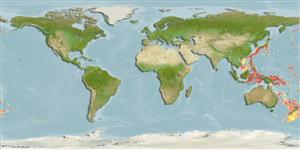Malacostraca |
Decapoda |
Geryonidae
Environment: milieu / climate zone / Mức độ sâu / distribution range
Sinh thái học
; Mức độ sâu 300 - 1500 m (Tài liệu tham khảo 343). Tropical
Western Pacific: Japan to Palau.
Length at first maturity / Bộ gần gũi / Weight / Age
Chín muồi sinh dục: Lm ? range ? - ? cm Max length : 30.0 cm CW con đực/không giới tính; (Tài liệu tham khảo 343)
Carapace hexagonal; dorsal surface (especially branchial regions) distinctly inflated; anterolateral teeth low in adults. Merus of legs long, slender, with dorsal subdistal tooth; dactylus of legs laterally flattened, height at midlength less than width at midlength. Color: uniform tan to cream color overall.
Commands high prices of up to US$60 to US$80 for a fresh crab of 20 cm width. Inhabits soft substrates in deep waters (Ref. 343).
Life cycle and mating behavior
Chín muồi sinh dục | Sự tái sinh sản | Đẻ trứng | Eggs | Sự sinh sản | Larvae
Members of the order Decapoda are mostly gonochoric. Mating behavior: Precopulatory courtship ritual is common (through olfactory and tactile cues); usually indirect sperm transfer.
Ng, P.K.L. 1998 Crabs. p. 1045-1155. In K.E. Carpenter and V.H. Niem (eds) FAO species identification guide for fishery purposes. The living marine resources of the Western Central Pacific. Volume 2. Cephalopods, crustaceans, holothurians and sharks. Rome, FAO. 1998. pp. 687-1396. (Tài liệu tham khảo 343)
IUCN Red List Status
(Tài liệu tham khảo 130435: Version 2025-1)
CITES status (Tài liệu tham khảo 108899)
Not Evaluated
CMS (Tài liệu tham khảo 116361)
Not Evaluated
Threat to humans
Human uses
Các nghề cá: Tính thương mại
FAO - Các nghề cá: landings | FishSource | Biển chung quanh ta
Các công cụ
Thêm thông tin
Sinh thái dinh dưỡngFood items (preys)
Thành phần thức ăn
Thành phần thức ăn
Các động vật ăn mồi
Population dynamicsSự sinh trưởngMax. ages / sizesLength-weight rel.Length-length rel.Length-frequenciesMass conversionSự phong phú Life cycleSự tái sinh sảnChín muồi sinh dụcSự sinh sảnĐẻ trứngEggsEgg developmentLarvae PhysiologyThành phần ô-xy
Human RelatedStamps, coins, misc.
Các nguồn internet
Estimates based on models
Preferred temperature
(Ref.
115969): 2.7 - 4.1, mean 3.4 (based on 414 cells).
Fishing Vulnerability
Low vulnerability (20 of 100).
Price category
Unknown.
